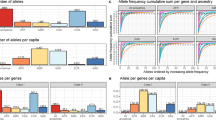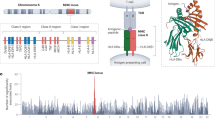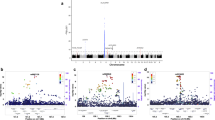Abstract
HLA-DRB1 codes for a major histocompatibility complex class II cell surface receptor. Genetic variants in and around this gene have been linked to numerous autoimmune diseases. Most notably, an association between HLA-DRB1*1501 haplotype and multiple sclerosis (MS) has been defined. Utilizing electronic health records and 4235 individuals within Marshfield Clinic’s Personalized Medicine Research Project, a reverse genetic screen coined phenome-wide association study (PheWAS) tested association of rs3135388 genotype (tagging HLA-DRB1*1501) with 4841 phenotypes. As expected, HLA-DRB1*1501 was associated with MS (International Classification of Disease version 9-CM (ICD9) 340, P=0.023), whereas the strongest association was with alcohol-induced cirrhosis of the liver (ICD9 571.2, P=0.00011). HLA-DRB1*1501 also demonstrated association with erythematous conditions (ICD9 695, P=0.0054) and benign neoplasms of the respiratory and intrathoracic organs (ICD9 212, P=0.042), replicating previous findings. This study not only builds on the feasibility/utility of the PheWAS approach, represents the first external validation of a PheWAS, but may also demonstrate the complex etiologies associated with the HLA-DRB1*1501 loci.
This is a preview of subscription content, access via your institution
Access options
Subscribe to this journal
Receive 6 digital issues and online access to articles
$119.00 per year
only $19.83 per issue
Buy this article
- Purchase on Springer Link
- Instant access to full article PDF
Prices may be subject to local taxes which are calculated during checkout

Similar content being viewed by others
References
Hindorff LA, MacArthur J, Wise A, Junkins HA, Hall PN, Klemm AK et al. A Catalog of Published Genome-Wide Association Studies 2012, Available at www.genome.gov/gwastudies.
Manolio TA, Collins FS, Cox NJ, Goldstein DB, Hindorff LA, Hunter DJ et al. Finding the missing heritability of complex diseases. Nature 2009; 461: 747–753.
Lango Allen H, Estrada K, Lettre G, Berndt SI, Weedon MN, Rivadeneira F et al. Hundreds of variants clustered in genomic loci and biological pathways affect human height. Nature; 1021: 832–838.
Wellcome Trust Case Control Consortium. Genome-wide association study of 14,000 cases of seven common diseases and 3,000 shared controls. Nature 2007; 447: 661–678.
Freudenberg J, Lee HS, Han BG, Shin HD, Kang YM, Sung YK et al. Genome-wide association study of rheumatoid arthritis in Koreans: population-specific loci as well as overlap with European susceptibility loci. Arthritis Rheum 2011; 63: 884–893.
Kochi Y, Okada Y, Suzuki A, Ikari K, Terao C, Takahashi A et al. A regulatory variant in CCR6 is associated with rheumatoid arthritis susceptibility. Nat Genet 2010; 42: 515–519.
Plenge RM, Seielstad M, Padyukov L, Lee AT, Remmers EF, Ding B et al. TRAF1-C5 as a risk locus for rheumatoid arthritis--a genomewide study. N Engl J Med 2007; 357: 1199–1209.
Raychaudhuri S, Remmers EF, Lee AT, Hackett R, Guiducci C, Burtt NP et al. Common variants at CD40 and other loci confer risk of rheumatoid arthritis. Nat Genet 2008; 40: 1216–1223.
Stahl EA, Raychaudhuri S, Remmers EF, Xie G, Eyre S, Thomson BP et al. Genome-wide association study meta-analysis identifies seven new rheumatoid arthritis risk loci. Nat Genet 2010; 42: 508–514.
Behrens EM, Finkel TH, Bradfield JP, Kim CE, Linton L, Casalunovo T et al. Association of the TRAF1-C5 locus on chromosome 9 with juvenile idiopathic arthritis. Arthritis Rheum 2008; 58: 2206–2207.
Chu X, Pan CM, Zhao SX, Liang J, Gao GQ, Zhang XM et al. A genome-wide association study identifies two new risk loci for Graves' disease. Nat Genet 2011; 43: 897–901.
Hakonarson H, Grant SF, Bradfield JP, Marchand L, Kim CE, Glessner JT et al. A genome-wide association study identifies KIAA0350 as a type 1 diabetes gene. Nature 2007; 448: 591–594.
Han JW, Zheng HF, Cui Y, Sun LD, Ye DQ, Hu Z et al. Genome-wide association study in a Chinese Han population identifies nine new susceptibility loci for systemic lupus erythematosus. Nat Genet 2009; 41: 1234–1237.
Anderson CA, Boucher G, Lees CW, Franke A, D'Amato M, Taylor KD et al. Meta-analysis identifies 29 additional ulcerative colitis risk loci, increasing the number of confirmed associations to 47. Nat Genet 2011; 43: 246–252.
Comabella M, Craig DW, Camina-Tato M, Morcillo C, Lopez C, Navarro A et al. Identification of a novel risk locus for multiple sclerosis at 13q31.3 by a pooled genome-wide scan of 500,000 single nucleotide polymorphisms. PLoS One 2008; 3: e3490.
De Jager PL, Jia X, Wang J, de Bakker PI, Ottoboni L, Aggarwal NT et al. Meta-analysis of genome scans and replication identify CD6, IRF8 and TNFRSF1A as new multiple sclerosis susceptibility loci. Nat Genet 2009; 41: 776–782.
Patsopoulos NA, Esposito F, Reischl J, Lehr S, Bauer D, Heubach J et al. Genome-wide meta-analysis identifies novel multiple sclerosis susceptibility loci. Ann Neurol 2011; 70: 897–912.
Australia and New Zealand Multiple Sclerosis Genetics Consortium (ANZgene). Genome-wide association study identifies new multiple sclerosis susceptibility loci on chromosomes 12 and 20. Nat Genet 2009; 41: 824–828.
Singer JB, Lewitzky S, Leroy E, Yang F, Zhao X, Klickstein L et al. A genome-wide study identifies HLA alleles associated with lumiracoxib-related liver injury. Nature Genet 2010; 42: 711–714.
Lucena MI, Molokhia M, Shen Y, Urban TJ, Aithal GP, Andrade RJ et al. Susceptibility to amoxicillin-clavulanate-induced liver injury is influenced by multiple HLA class I and II alleles. Gastroenterology 2011; 141: 338–347.
McCarty CA, Chisholm RL, Chute CG, Kullo IJ, Jarvik GP, Larson EB et al. The eMERGE Network: a consortium of biorepositories linked to electronic medical records data for conducting genomic studies. BMC Med Genomics 2011; 4: 13.
Pendergrass SA, Dudek SM, Crawford DC, Ritchie MD . Visually integrating and exploring high throughput phenome-wide association study (PheWAS) results using PheWAS-View. BioData Min 2012; 5: 5.
Denny JC, Crawford DC, Ritchie MD, Bielinski SJ, Basford MA, Bradford Y et al. Variants near FOXE1 are associated with hypothyroidism and other thyroid conditions: using electronic medical records for genome- and phenome-wide studies. Am J Hum Genet 2011; 89: 529–542.
Pendergrass SA, Brown-Gentry K, Dudek SM, Torstenson ES, Ambite JL, Avery CL et al. The use of phenome-wide association studies (PheWAS) for exploration of novel genotype-phenotype relationships and pleiotropy discovery. Genet Epidemiol 2011; 35: 410–422.
Denny JC, Ritchie MD, Basford MA, Pulley JM, Bastarache L, Brown-Gentry K et al. PheWAS: demonstrating the feasibility of a phenome-wide scan to discover gene-disease associations. Bioinformatics 2010; 26: 1205–1210.
de Bakker PI, McVean G, Sabeti PC, Miretti MM, Green T, Marchini J et al. A high-resolution HLA and SNP haplotype map for disease association studies in the extended human MHC. Nat Genet 2006; 38: 1166–1172.
McCarty CA, Wilke RA, Giampietro PF, Wesbrook SD, Caldwell MD . Marshfield clinic personalized medicine research project (PMRP): design, methods and recruitment for a large population-based biobank. Pers Med 2005; 2: 49–79.
Turner SD, Berg RL, Linneman JG, Peissig PL, Crawford DC, Denny JC et al. Knowledge-driven multi-locus analysis reveals gene-gene interactions influencing HDL cholesterol level in two independent EMR-linked biobanks. PLoS One 2011; 6: e19586.
Acknowledgements
This study was funded by NLM grant 5T15LM007359, NIGMS grant R01GM097618, NCATS grant UL1TR000427 and NCRR grant 1U1RR025011. In addition, the authors gratefully acknowledge the support from the Marshfield Clinic Research Foundation through the Personalized Medicine Research Project.
Author information
Authors and Affiliations
Corresponding author
Ethics declarations
Competing interests
The authors declare no conflict of interest.
Additional information
Supplementary Information accompanies the paper on Genes and Immunity website
Rights and permissions
About this article
Cite this article
Hebbring, S., Schrodi, S., Ye, Z. et al. A PheWAS approach in studying HLA-DRB1*1501. Genes Immun 14, 187–191 (2013). https://doi.org/10.1038/gene.2013.2
Received:
Revised:
Accepted:
Published:
Issue Date:
DOI: https://doi.org/10.1038/gene.2013.2
Keywords
This article is cited by
-
pyPheWAS: A Phenome-Disease Association Tool for Electronic Medical Record Analysis
Neuroinformatics (2022)
-
Phenome-wide association study identifies marked increased in burden of comorbidities in African Americans with systemic lupus erythematosus
Arthritis Research & Therapy (2018)
-
A simulation study investigating power estimates in phenome-wide association studies
BMC Bioinformatics (2018)
-
Rare variants in drug target genes contributing to complex diseases, phenome-wide
Scientific Reports (2018)
-
Current Scope and Challenges in Phenome-Wide Association Studies
Current Epidemiology Reports (2017)



